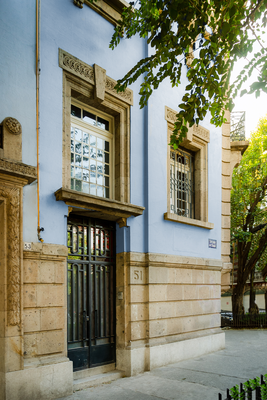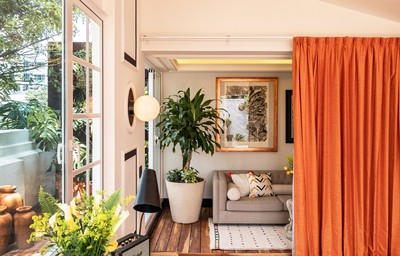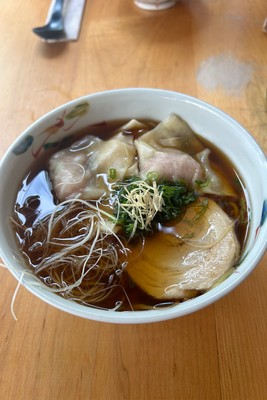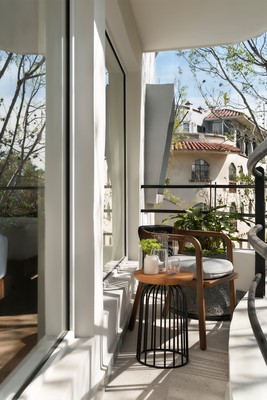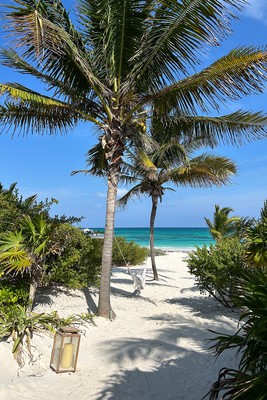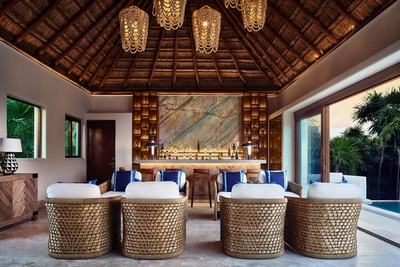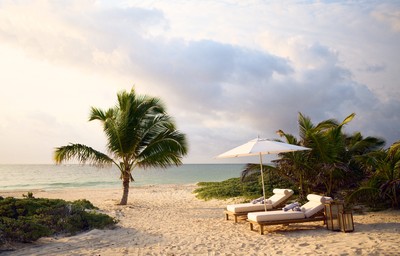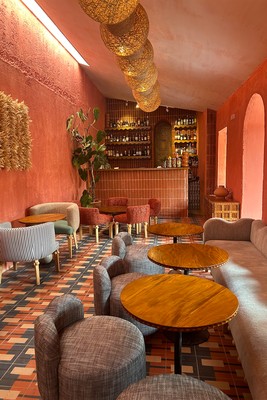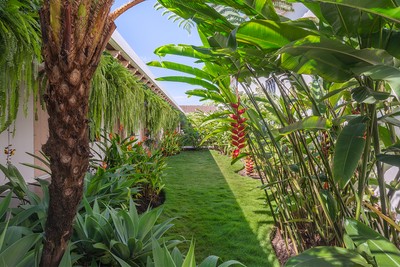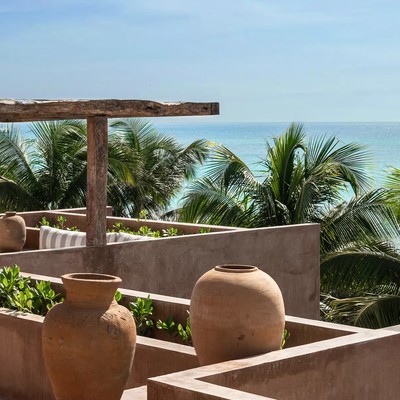
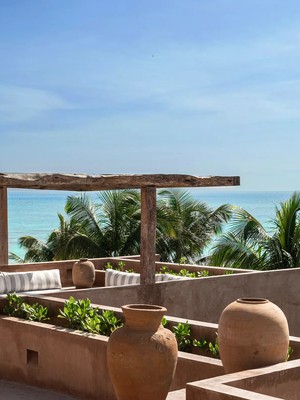
A Tried-&-Tested Guide To Mexico & Guatemala
MEXICO
Mexico City
Mexico City is roughly the same size as London, so it’s worth setting aside at least five to seven days to explore its diverse neighbourhoods, see the main sites, and try as much street food as possible. North America’s most populous city is a metropolis of contrasts, with centuries-old architecture that reflect Mayan history, new developments helping to drive tourism to the suburbs, and the towering, ancient Teotihuacan Pyramids. You’ll want to book the most popular museum and galleries ahead of time – including the cobalt blue Frida Kahlo Museum – as tickets sell out weeks in advance. Getting around is easy; there’s a good metro (with women- and children-only carriages) and bus network, while Ubers are very affordable, costing around £5 for a 20-minute journey.
See & Do: There’s so much to see, but a good place to start is the city centre. Here, you can visit the vast main plaza Zocalo on which sits the cathedral and the ruined Aztec Templo Mayor. To the south, you’ll find the historic districts of San Angel and Coyoacan, home to art galleries, cool cafés and the former homes of Diego Rivera and Frida Kahlo. I also loved Chapultepec Park, the biggest and one of the oldest parks in Latin America. Locals sell everything from snacks to souvenirs along the paths, and there’s a free zoo home to giraffes, pandas, flamingos and other animals. The park is also home to the National Museum of Anthropology and the Museum of Modern Art, both of which are worth visiting if you don’t mind queuing.
You should also stop by the Floreria Mercado Jamaica (flower market) to see an abundance of flowers of all varieties and enjoy an evening watching the city’s famous lucha libre to watch wrestlers battle it out in the ring. Locals head here every Friday so there’s usually a buzzy atmosphere and plenty of free-flowing beer. Finally, book a hot air balloon ride over the Teotihuacán Pyramids for a bucket-list experience. After lots of research we booked our experience with Aerodiverti, a reputable company which offers pick up and drop off, plus a tour of the pyramids. The rides usually take place at sunrise, so expect an early wake-up call and wrap up warm as the morning can be chilly. Another highlight was going to a football match at the Estadio Ciudad de los Deportes stadium, home to the city’s Cruz Azul team. Tickets were fairly cheap and you can tuck into snacks and drinks – served to your seat by eager locals selling beers, crisps and meals – during a match.
Back on ground, I loved exploring the Condesa neighbourhood, home to cool hotels, restaurants, cafés and vintage shops. This trendy area has some great street food spots (you’ll find most on unassuming street corners), as well as galleries and the beautiful Parque México park. Another must-visit area is Roma Norte, the city’s artistic quarter. You’ll find a mix of art nouveau, art deco and modernist architecture, as well as restaurants that sprawl out onto the street. Here, locals enjoy coffee and conchas (a type of Mexican pastry) in the morning, followed by long lunches in the afternoon. There are also lots of cool boutiques, including ceramic shop Esculturas Vivas, and Vintage Hoe which has upcycled vintage pieces from around the world.
Eat & Drink: Where to start? A month wouldn’t be long enough to make your way around the city’s best restaurants. That said, a week is enough time to get a feel for Mexico City’s buzzy food scene, with its Michelin-starred restaurants, taquerias and street food vendors. If you book one experience, make it the Eat Like a Local food tour. This female-founded and led company offers day and evening food tours across some of the city’s best street food vendors, including numerous spots you wouldn’t find without a guide. During our five-hour tour, we ate several tacos and tostadas (topped with everything from slow-cooked pork to charred spring onions and feta), grilled and stuffed corn, spicy chorizo, exotic fruits and a delicious baked flan. There were even some deep-fried insects and scorpions. Extra portions are encouraged and some of the proceeds go back to the company’s social project which supports young girls in the local community.
One of the city’s buzziest restaurants right now is Contramar, a seafood restaurant in Roma Norte. Booking in advance is a must to try its menu of fish tacos, ceviche and sharing dishes like king shrimp salad and fried squid on toast. The team also own a string of other restaurants across the city, including Caracol De Mar, a fine dining outpost, and Itacate Del Mar which is more laidback. Another favourite spot was Madre Café, a lively spot with DJs and cocktail trolleys – think jalapeño margaritas served at your table.
For excellent tacos, squeeze in at a table at El Turix, Marlindo or Siembra Taquería, all great options for authentic dishes served with a selection of spicy salsas. Another rustic spot to visit is Casa de tono, a favourite amongst locals for its quesadillas and pozole, a Mexican soup served with pork cheeks and other cuts of meat. Over in the upmarket Polanco neighbourhood, La Docena is an elegant oyster bar where you can tuck into towering seafood platters with delicious cocktails.
Finish with something sweet at El Moro which has several sites across the city. The team has been making hot, sugary churros for nearly a century so order a few with chocolate or caramel sauce and enjoy it with a chocolatey drink like a milkshake or cup of hot cocoa. I also loved the pastries and sweet treats at Pastelería Ideal, a kitsch bakery that makes thousands of cakes and pâtisserie each day.
Sleep: There are so many cool hotels in Mexico City. I stayed in three to get a feel for the different neighbourhoods. For a luxury stay, check into La Valise in Roma Norte. At the start of the year the hotel added an additional five suites to its original three. Set in a beautiful French-style townhouse, the hotel has eclectic interiors with light-filled rooms and tasteful pops of colour. Two rooms even have slide-out beds that roll onto the terrace/balcony. Thoughtful extras in the room include Sonos speakers, projectors for movie nights, and minibars stocked with local drinks. A generous breakfast of yogurt, pastries, coffee and juice is delivered to your room each morning, and there's a pool in the adjoining building.
From there, we checked into the newly opened Kimpton Virgilio, an IHG property, in Polanco (the city’s equivalent to Marylebone or Belgravia). The team were friendly and helpful throughout our stay and helped us arrange transfers and laundry services. The hotel itself has spacious rooms with modern en-suites and comfy beds, as well as a Spanish and Latin-inspired tapas bar and lounge, and a buzzy rooftop pool. Best of all, the hotel is within walking distance of some of the city’s best restaurants, bars and shops. Lastly, we spent two nights at the colourful Mondrian Mexico City in Condesa, one of Ennismore’s Latin properties. Rooms and suites are simple but comfortable, and the rooftop restaurant is the perfect spot for breakfast or sundowner cocktails. The ground floor has a cool flower shop, and the hotel is a short walk to Roma Norte.
Yucatan Peninsula
In the southeast corner of Mexico, between the Gulf of Mexico and the Caribbean, the region comprises three states: Yucatan, Campeche and Quintana Roo. The peninsula also encompasses parts of Belize and Guatemala, and the area as a whole was the birthplace of the Mayan civilisation. Most travellers make a beeline for Tulum or Holbox to swim in its clear waters and sip margaritas on the pristine beaches. Across the region, you’ll find hundreds of Mayan ruins, from the famous Chichen Itza and Uxmal to much smaller sites, as well as Tulum’s cluster of ruins mounted on the cliffs. These, together with the white sand beaches of the Riviera Maya that stretch from Cancun to Punta Allen against a backdrop of dense jungle teeming with flora and fauna, make the area ideal for first-time visitors. Along the coastline there’s a vast choice of accommodation, from quirky hostels to ultra-luxe hotels. Most visitors fly into Cancun and take a shuttle or private transfer to the beaches, but you can also now head straight to the newly opened Tulum airport.
See & Do: Skip Cancun (which is more commercialised than other parts of the region) and head to Holbox, a beautiful car-free island where you can walk along the white sand beaches and spend evenings in fun bars and restaurants. One of the best things to do is head on a tour to see the bioluminescence – the natural phenomena of millions of glowing microorganisms in the ocean. It occurs year-round and there are numerous tour guides on the island offering daily excursions. You should also rent a golf buggy to get around the island and visit the nature revere to the north where you’ll spot flamingos and other exotic birds. Over in Tulum, skip the main town and head straight to the beaches. Most people hire bikes to get around as taxis can be very expensive. Spend an afternoon visiting its famous ruins and relaxing at one of the beach clubs. There are also endless opportunities for water sports, including kite surfing, snorkelling, diving and surfing. Just keep in mind the tide can be very strong in this part of the country, so take caution and don’t go swimming alone.
Eat & Drink: It’s hard to go wrong in Holbox, which is home to numerous restaurants and cafés serving food made with local produce. Painapol makes smoothie bowls and brunch dishes, while Naay serves salads and grilled seafood. La Tortilleria serves delicious tacos, and Roots Pizza is a relaxed spot where you can enjoy pizzas on the beach. For a special dinner, head to Luuma with its wicker furniture and boho chic interiors. Tacos, ceviche, and grilled meats and seafood are served alongside delicious cocktails, while DJs set the vibe. In Tulum, you’ll find great restaurants at the boutique hotels, as well as numerous beach clubs for live music and lounging – RosaNegra has a fun atmosphere and serves great cocktails. For breakfast and brunch, head to DelCielo, a small restaurant that serves acai bowls and typical Mexican breakfast dishes. I also loved Liquido y Solido, a laid-back spot serving salads, sandwiches and smoothies. Lastly, Panna e Cioccolato makes delicious gelato, ice-cream and ice lollies.
Sleep: My favourite hotel of the whole trip was Casa Chablé, a boutique property in the Sian Ka'an Biosphere Reserve, a protected UNESCO site. Just south of Tulum, guests can reach the property via a 40-minute boat ride through mangroves and ocean. On the private islet, there are only ten rooms, so at times you’ll feel like you’re on your own private beach with its white sand and clear waters. There are five beachfront villas with outdoor showers, and a main villa with five suites. Guests can swim in the outdoor pool, relax in a cabana or sun lounger on the beach, and take kayaks out to sea. There’s also a gym and a wellness esplanade for yoga, sound bath sessions and meditation, plus a thatched-roof restaurant where you’ll enjoy all your meals. Breakfast might be huevos rancheros with fresh juice, while lunch could be grilled lobster or seafood tacos washed down with passion fruit margaritas. We stayed at the hotel for three nights (and even extended our stay) as the service was excellent – the friendly team can help arrange everything from transfers to romantic dinners on the beach. The group also has two other properties in the region – Chablé Maroma and Chablé Yucatan, both of which are equally luxe.
Over in Tulum we stayed at the newly opened Xela, a boutique hotel owned by the same group behind La Valise. This beach-front property has 12 rooms, some with kitchenettes and balconies, others with ocean views. The main hotel is terracotta-washed and revolves around an open lounge that leads out to the outdoor pool and beach. Guests can relax on day beds and order food and cocktails to their table or eat in the main restaurant which serves club sandwiches, burgers and pizzas, as well as tacos and other Mexican dishes. There are complimentary yoga classes and a small wellness area for massages and other treatments.
Useful Info
- Numerous airlines run daily flights to various parts of Mexico, including Mexico City and Cancun. Most have connecting flights in the US, but you can find direct flights which are more expensive. Don’t forget to purchase an ESTA if you’re connecting in the US.
- The best time to visit is during the dry season from December to April, when temperatures range between 24°C and 31°C.
- Pre-book transfers from airports and avoid airport taxis which can be very expensive.
- Most the country is safe to travel to, but there are some areas to avoid so it’s worth doing your research if you’re heading off the beaten track. Do not visit Tepito in Mexico City which is the most dangerous area known for gang and cartel violence.
- SIM cards are cheap and easy to find at corner shops and supermarkets – it’s worth buying one to avoid overseas data charges.
GUATEMALA
Antigua
Most travellers' first stop in Guatemala is the former capital, Antigua. We were advised to skip the current capital Guatemala City as it’s not considered to be as safe as other parts of the country, but you could easily spend a day or two exploring Central America’s largest capital, with its Mayan museums and street food vendors. That said, if you’re strapped for time, head straight to Antigua, a small city in the south. It was declared a Unesco World Heritage Site in 1979 thanks to its ancient ruins and colourful architecture from every age dating back nearly 500 years. From Guatemala City airport, it takes around 90 minutes to reach Antigua along winding roads – the city is 1,545m above sea level so it’s cooler than other parts of the country. During our first night we stayed at the Good Hotel t o break up the journey after a long flight. The hotel has modern interiors, friendly staff who speak fluent English (not a given) and a cool rooftop bar and restaurant. I’d recommend avoiding airport taxis and booking a transfer or uber which are both safe travel options.
See & Do: One of the first things you’ll notice in the small city is the cascading volcanoes and mountains that dominate the skyline. Many tourists hike the nearby Acatenango Volcano (3,976m) during a two-day or overnight hike. Not for the faint-hearted, it’s a challenging hike, but the views from the top are breath-taking. Back in the city, its long cobblestone streets are lined with pretty pastel-coloured houses, boutique hotels, smart shops, galleries, and buzzing cafés and restaurants. We spent four days exploring the small neighbourhoods and visiting the historic San José cathedral and Iglesia de la Merced church. The old town is also beautiful, while the main market has a buzzy atmosphere with locals selling everything from clothes to quesadillas. You can also hike (or take a tuk tuk) to Hill of the Cross for incredible city views, take a traditional cooking lesson at La Tortilla Cooking School, and head out on day trips to the surrounding valleys and hills to discover coffee farms and indigenous villages.
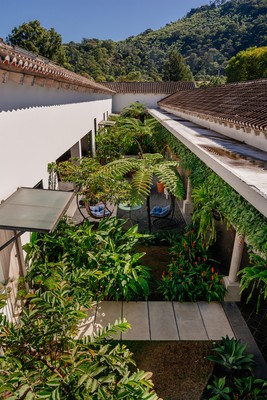
Eat & Drink: For a small city, Antigua has an excellent food scene with cool cafés, small restaurants and plenty of bars serving Guatemalan beers. One of my favourite spots was Los Tres Tiempos, a colourful restaurant which serves modern Guatemalan dishes as well as classics like tacos and enchiladas with spicy salsas. My favourite dish was a vegetarian platter featuring grilled corn, cheese, peppers, plantain, courgettes and more – washed down with tamarind margaritas. For incredible tacos, visit Taqueria la Katrina, a tiny restaurant with only a few seats, then head to the nearby Café Boheme for cocktails. Antigua Brewing Company is a buzzy spot that pumps out tunes and serves its own local beer. Plus, just outside of the city centre, Caoba Farms (open Wednesday to Sunday) is a farm-to-table restaurant where you can enjoy long lunches, then visit its plantation. Lastly, don’t miss a trip to McDonald’s – not for the food, but to see the ex-colonial building it’s housed in. Considered to be one of the chain’s most beautiful outposts, it has a huge garden and an outdoor terrace you won’t find elsewhere.
Sleep: There are numerous hostels and homestays if you’re on a budget, but if extra space and aircon are non-negotiables, book a stay at Good Hotel Antigua, a smart hotel within walking distance but tucked away from the city centre. Set in a converted mansion the hotel is surrounded by lush greenery and gardens, with numerous communal spaces for lounging with a book. Rooms are light-filled and minimally decorated, with furniture made from reclaimed wood. Nearly everything here is local, from the artwork on the walls to the coffee and food at the indoor/outdoor restaurant. Elsewhere, many of the restored Spanish colonial buildings have been converted into hotels, including the luxe El Convento, next to the 18th-century Capuchin convent. There are 25 suites with modern amenities, as well as an outdoor pool, rooftop terrace and incredible volcano views.
Lake Atitlan
Surrounded by three volcanoes, this is one of the most beautiful and captivating lakes in the world. The shoreline is dotted with traditional villages – the main ones to visit being San Antonio Palopó, Santiago Atitlán and Sololá – where you’ll find Mayan culture which has survived for centuries. The lake is harder to reach than the country’s cities, but one of the safest ways to get there is via a shuttle transfer followed by a boat ride. The roads are steep and winding, so I’d recommend taking anti-sickness travel tablets to ward off any queasiness. Lake views are more than worth the journey. Shuttles stop at Panajachel, where you can catch a boat to your accommodation (most Airbnbs and homestays have private docks).
See & Do: Here, it’s all about total relaxation. Lake life is relaxed and slow, for both locals and tourists who spend their time swimming in the lake (don’t swallow the water as it’s unsanitary) and visiting the small lakeside towns. If you visit just one, go to Sant Juan, a vibrant and colourful village with cool street art and friendly locals selling coconuts, frozen bananas and cocktails on the streets. Spend an hour exploring the market stalls before stopping for drinks and hopping back on a boat. Other things to do around Atitlan include trips with local fishermen, kayaking, cycling around the lake, a visit to a coffee farm and zip-lining through the trees in the Reserva Natural Atitlán. A short journey up the road will take you to Chichicastenango, famous for its colourful Thursday and Sunday markets, offering produce and textiles brought by local farmers and artisans.
Eat & Drink: Street food is king around Lake Atitlan. I recommend eating little and often, and there’s usually not much need to venture too far to find a meal. Avoid seafood but look out for grilled corn, torn tortillas topped with slow-cooked pork (slightly bigger than tacos), stuffed peppers, fried plantain, tostadas and helados de frutas – frozen fruit covered in chocolate and topped with chopped nuts.
Sleep: Hotels in Lake Atitlan can be expensive, so we found a reasonably priced Airbnb in the small village of Tzununa. Maya Moon has several hillside cabins and apartments, all with beautiful views of the lake. Amenities are simple, but each one has a small kitchenette, en-suite bathroom and either outdoor gardens or balconies with hammocks. Best of all, the restaurant is open for breakfast through to dinner with typical Guatemalan dishes and Western options like sandwiches and pasta. The team is friendly and helpful and can help with everything from laundry services to recommended things to do in the local area. Another good option is La Casa Del Mundo, a beautiful hostel that’s usually fully booked thanks to its spectacular views and community feel. There’s an on-site restaurant and bar plus kayaks for hire. And if you want to go all out, Casa Palopó is a luxury villa-like boutique hotel with a heated plunge pool and yoga platforms with panoramic views. Rooms are spacious and light-filled, some with modern and minimalist interiors, others with traditional artwork and moody colours.
Flores & Tikal
Mexico's Mayan ruins Chichen Itza is a must-see, but Guatemala’s ancient site Tikal is even more impressive. Over 140,000 acres of tropical jungle, wetlands and savannah are home to ancient ruins of Mayan civilization, built between the sixth and tenth century. Today, it’s a national park which extends into neighbouring Mexico and Belize. The site includes temples and pyramids which reflects the genius of the Mayan civilisation. You’ll also spot lots of wildlife – the park is home to jaguars, pumas, ocelots, howler monkeys and over 300 species of bird. During a tour we spotted woodpeckers, monkeys, white-nosed coatis, and iguanas. Visitors can book sunrise, day or sunset tours – avoid the latter if you don’t want to see spiders and other creepy crawlies. Tikal is on the other side of the country, so skip the 12-hour bus ride and fly from Guatemala City to Flores, the closest town in the northern Petén region. There are daily flights and the journey takes around an hour. This part of the country is hot – so expect highs of 40°+ during the dry season.
See & Do: Flores is a small town without a huge amount to explore, but Tikal is the main reason to visit. We booked a tour via Get Your Guide, which has hundreds of experiences across Guatemala and Central America, which included a private English-speaking guide and lunch at the on-site restaurant (a feast of Guatemalan cuisine). From pick up to drop off the tour takes around eight hours, so make sure to bring water, sun protection, insect repellent and comfortable walking shoes. Back in Flores, visitors can kayak on the central lake and book a day trip to Crater Azul to swim in the turquoise river.
Eat & Drink: You won’t find upmarket restaurants in Flores but there are a few nice neighbourhood spots worth visiting. Raices Bar & Grill is an indoor/outdoor restaurant overlooking the lake and the town’s main jetty. Friendly waiters serve guacamole with tortilla chips, seafood dishes and pizzas. You might even spot turtles swimming in the waters below. Another good option is Bistro Puertas del Cielo, tucked away from the main square on a quiet street lined with colourful buildings. The food is simple but hearty, with dishes like Guatemalan stews, pastas and salads. For sunset cocktails, head to Sky Bar which has panoramic lake views. There’s a fun, relaxed vibe in the evening, plus plenty of tequilas and mezcals on offer.
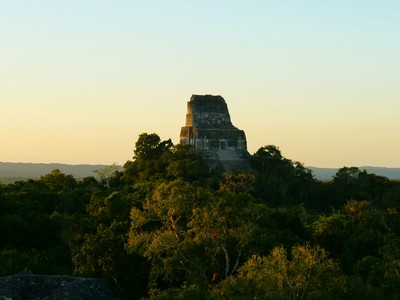
FLORIAN DELÉE/ UNSPLASH
Sleep: During a trip you’ll probably stay in Flores, or another town in Peten, for a night or two. You won’t find many luxury hotels, but there are plenty of homestays and b&bs. We stayed at Casa Ramona, which was fairly basic but centrally located and had everything we needed for a couple of nights – clean rooms, aircon, quiet communal areas and friendly staff who helped us with recommendations in town. A little further towards Tikal is La Lancha, a small, boutique hotel owned by Francis Ford Coppola (the film director has numerous properties across Belize, Guatemala and Argentina). Set beside the shores of Lake Petén Itzá, this ten-room lodge is surrounded by rainforest home to howler monkeys and cicadas. Everything from the furniture to the food is locally sourced, and rooms have either lakeside docks or balconies with hammocks. There’s a split-level pool with sun loungers and deck chairs, plus a restaurant with a wood-fired oven for cooking pizzas and tortillas.
Useful Info
- Currently, there are no direct flights from London to Guatemala City, but United Airlines offers connecting flights from numerous US cities, including NYC and Denver. Don’t forget to purchase an ESTA if you’re connecting in the US.
- The best time to visit is during the dry season from November to April, when temperatures range between 23°C and 32°C in most parts of the country.
- Guatemala is a Spanish speaking country, so it’s best to brush up on some basic phrases to get around. Also, cash is king, so don’t forget to exchange money into Guatemalan quetzales.
- While the majority of the country is safe for tourists, some parts can be dangerous, so avoid travelling late (or alone) at night, carrying large amounts of cash, or displaying valuables like jewellery and tech.
- SIM cards are cheap and easy to find at corner shops and supermarkets – it’s worth buying one to avoid overseas data charges.
DISCLAIMER: We endeavour to always credit the correct original source of every image we use. If you think a credit may be incorrect, please contact us at info@sheerluxe.com.
